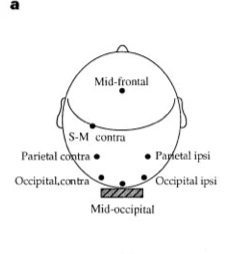Cohen et al. (1997)
From Psy3241
Functional Relevance of Cross-Modal Plasticity in Blind Humans
Contents |
Previous Research
Imaging studies have shown that the visual cortex can be activated by reading Braille and other tactile tasks, in people who have been blind from an early age.
When applied to the occipital cortex, Transcranial magnetic stimulation interferes with sight of letters in normal seeing participants
Goal of the Current Study
To examine if the visual cortex can process somatosensory information in a functionally relevant manner.
Methods
Five experienced Braille readers who had suffered from blindness early in life were asked to read lines of non-word Braille letters (EBB). Five normal sighted participants (SVR) and four early-blind participants (EBR) were asked to identify and read aloud, embossed Roman letters. Their voice was recorded, along with the muscle movements in their hand. These were recorded to determine the latency period between feeling the letter and reading it aloud.
The tasks were performed in the absence of TMS, with the TMS in the air and with the TMS on different areas of the scalp.

Results
In the EBB group, occipital stimulation sometimes caused distorted somatosensory perceptions. The participants reported that some dots felt like they were missing, sometimes they felt extra dots, or that the dots did not make sense. Stimulation to the mid-occipital region also caused more errors in both the EBB and EBR group, than when the TMS was in the air. This implies that the occipital cortex is functioning during somatosenosry perception, (not only during Braille reading) of those who have been blind from an early age.
Speech was not affected by any site of TMS, and errors in the speech recordings were attributed to disruption of letter discrimination. Unlike the EBB group, the SVR group did not report distorted perceptions of letters when their occipital cortex was stimulated. This finding indicates that the occipital cortex is not activated when normal sighted people are reading tactile information. When TMS stimulation of the contralateral sensorimotor cortex caused the participants hands to move, the SVR group showed significantly more errors than either EB group. Cohen et al (2007) attributed this finding to their inexperience, suggesting that they may have spent more feeling the letters, making them more vulnerable for the stimulation to affect their reading.
Conclusion
Those who are blind from an early age have plastic changes in their occipital cortex, which allows it to become activated during a tactile task, such as reading Braille or Roman letters.
